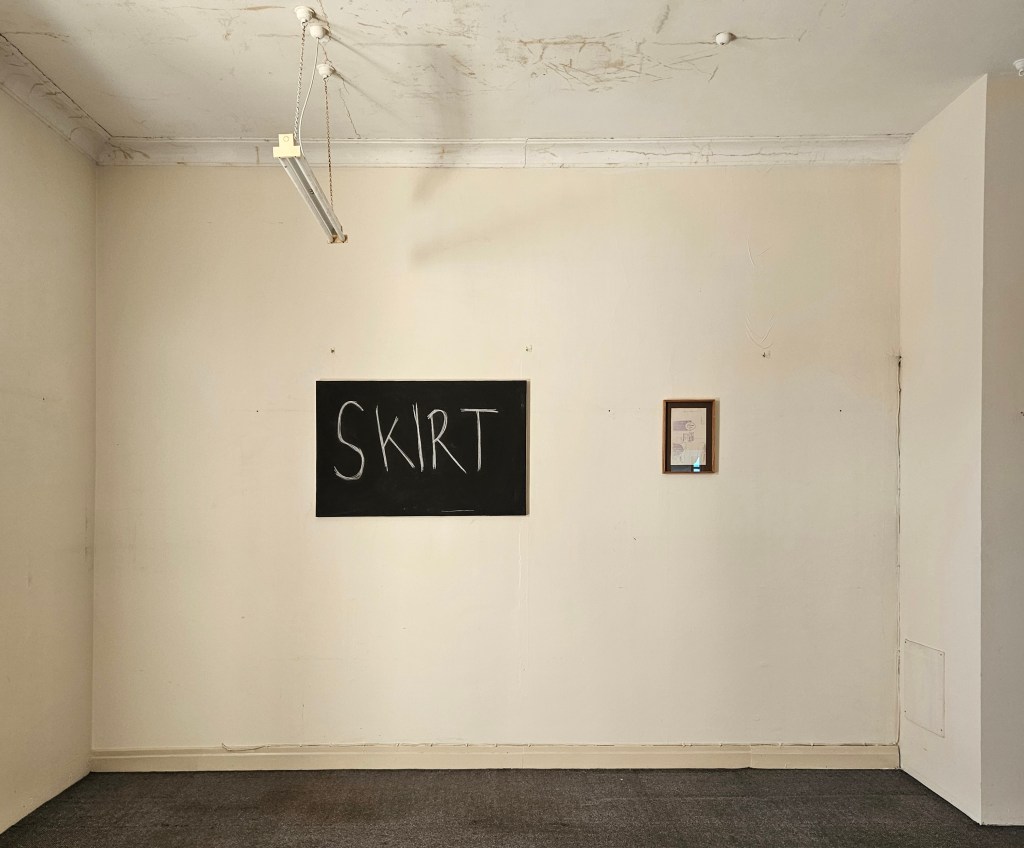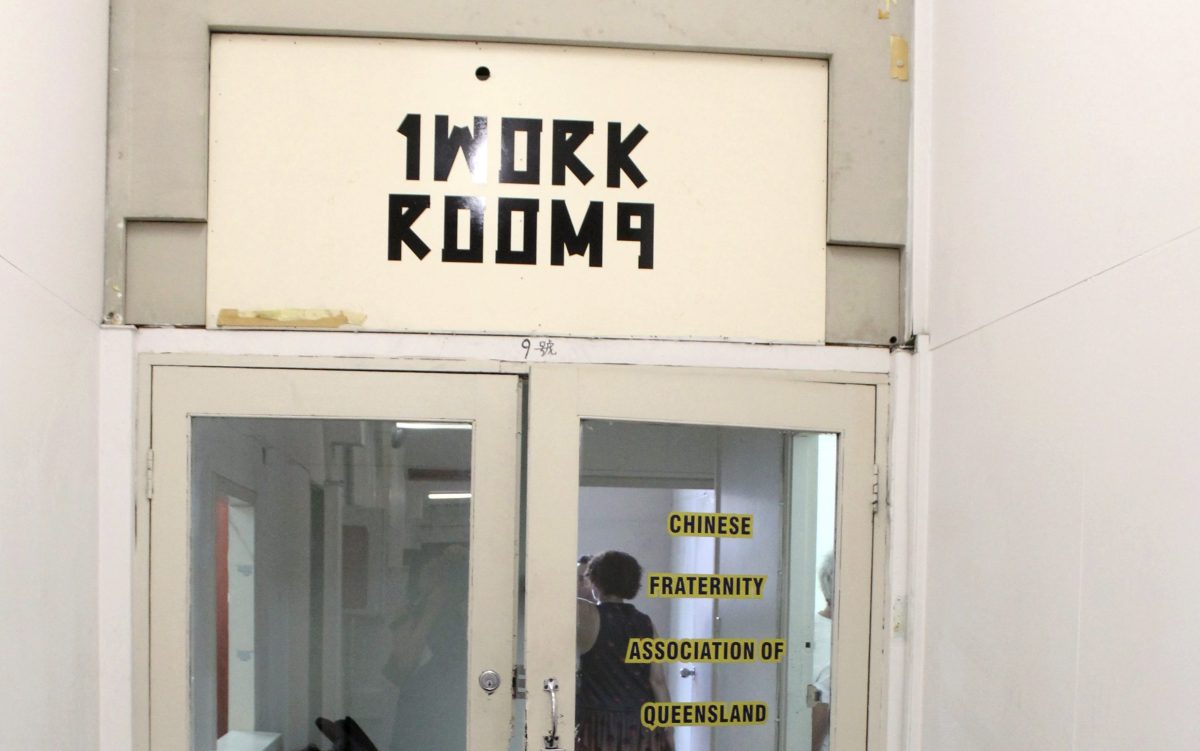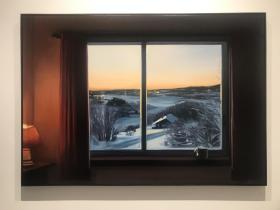Through an innovative approach to exhibition design, 1WORKROOM9, instigated by Speculative Architecture critically engages its space, building and suburb.
The new project space opened in Meanjin/Brisbane’s Chinatown a fortnight shy of the Year of the Dragon, with two compelling artworks by Kamilaroi and Bigambul artist, Archie Moore.
Principal of the architectural firm, Dirk Yates, says of his new initiative, ‘There is an interest in focusing on one work, particularly exhibitions that are installations or focus on the experience of the audience engaging with the project… I consciously don’t want it to be a white cube; I enjoy the principle of dealing with context.
‘The first exhibition breaks this (sort of) rule, by presenting two works by the artist,’ adds Yates.
Archie Moore: One Work From the Collection of Rebecca Ross and One From the Collection of Dirk Yates, was born from discussions between Yates and Ross, and an expressed desire to stage a send-off for the Australian representative in the 2024 Venice Biennale.
The artwork loaned by Ross is ‘Metonym’ from Words I Learned from the English Class (2002), which solely comprises the word ‘SKIRT’ written in chalk onto a canvas coated with blackboard paint. Yates’ untitled print (2007) of Moore’s, was signed ‘Grubbanax Swinnasen’. It depicts a male teacher spying up skirts worn by female students. The words, ‘Oops! Accidentally dropped my pencil again!’ appear in a speech bubble.

In relation to the two artworks being brought together for this exhibition, Yates says, ‘[There is] a really interesting through line about how [Moore] is taking those experiences and representing them.’ They evoke the adolescent’s classroom experience, language and sexual objectification – and how those are represented in two artworks albeit five or six years apart.
‘I think it is a compelling exhibition and art experience,’ says Yates.
Extending the picture
While the artworks are relatively small, their installation in a room with 1980s décor makes for an immersive experience. Not unlike a school from Moore’s youth, the lighting is suspended fluorescent, the carpet is blue grey low pile, and the walls are filled with redundant fixings.
Yates began considering establishing an exhibition space after moving into his office down the corridor four years ago. The building, which is situated in an area he refers to as ‘old Chinatown Mall’, was named King Edward Chambers after the era in which it was constructed. It was designed in 1905 by antipodean architects Francis Hall and Robin Dobs for Irish immigrant, Peter Murphy.
1WORKROOM9 is located in the former Chinese Fraternity Association of Queensland office, which was vacated in October 2023. The Association’s name remains on the front door in vinyl lettering. The floor appears to have retained other Chinese tenants, such as the DXO Chinese Medicine Clinic and the Chinese Cultural Leisure Centre. In 1922, the Kuomintang or Chinese Nationalist Party, also established a branch in the building. It was sold to the Chinese couple Gum Hoy and Lai Ming Yuen in 1979.
Yates describes the appeal of ‘a family owning a building for a long time who are not looking to capitalise with a high return’. Since he established Speculative Architecture on the premises, Outer Space and Cyber Palace have also taken up tenancies.
The artist who runs the latter, Tara Pattenden, says, ‘I love that I have the end of the building to myself, the high ceilings and being able to work late.’ She is in the process of setting up her own gallery in a building across the road.
Cultural failings of Brisbane’s Chinatown
Yates’ appraisal of the building as being “Chinese” refers to the renovations that accompanied the council designation of the precinct as a Chinatown. Launched during Chinese New Year in 1987, this construction reflected a local government desire to create a tourism attraction that addressed the redneck reputation of south-east Queensland. King Edward Chambers was central to this redevelopment.
Chinatowns are typically sedimented over decades of settlement, with enclaves emerging to offer protection to their occupants. During the 19th century, Fortitude Valley was a furniture-making district. This attracted a small number of Chinese carpenters and associated compatriots to service their needs.
Chinese restaurants also flourished in Fortitude Valley during the World War II, to accommodate US servicemen who favoured the cuisine. However, the Chinese Quarter near the present day Botanic Gardens, where boarding houses were situated, was attacked during a riot in 1888. Reflective of an inability to establish a safe place in Brisbane, Chinese residents would not achieve critical mass until the 1980s. The former farming district of Sunnybank presented an ideal location.
Brisbane City Council, through a Fortitude Valley Chinatown Advancement Committee, sought to build its Chinatown between the 1982 Commonwealth Games and Expo88. It was arguably fashioned to meet the imaginings of other Australian settlers, with exaggerated exotic features, in a location without a significant population of Chinese residents. This was despite consultation with the Bureau of City Planning and City Government, the Chinese Club of Queensland and Chinese business proprietors. The latter were vocal about their concerns over the authenticity of the outcome, and as a consequence tenancy remained low.
Creatives capitalise
This initiative in the Fortitude Valley was also intended to revitalise a retail district, which had boomed between the 1930s and 60s but degenerated into a red light zone, one of those implicated in the Fitzgerald Inquiry.
It was shortly after an infamous 1973 arson attack on the Whiskey Au Go Go nightclub, which killed 15 people, that the Institute of Modern Art (IMA) was established as an independent gallery. Since 1975, it has played a pivotal role in the arts ecology by providing a place for critical coalescence among curators, artists and audiences. It was situated on the corner of Ann and Gipps Streets between 1993 and 2000, and has since been located on Brunswick Street.
In the year Lindy Lee graduated from the Sydney College of the Arts, the IMA staged Lindy Lee and Jane Burchill: Rites of Delay. Other artists to have exhibited there include Robert MacPherson, Diane Arbus, Hany Armanious, Judy Watson and Imants Tillers.
Yates also recalls the artist-run-initiatives, Isn’t Studios, which operated on Gipps Street in the 1990s, and No.9, which opened on Duncan Street during the 2000s.
Truth to material
Unlike a majority of Brisbane’s Chinese population, Yates lives close to Chinatown, saying, ‘There’s an enjoyable thing about walking to work.’ His relational approach to curatorship, and truth regarding the environment in which the art is being presented, activates the heritage of the site.
Read: Artists highlight the heightening issue of homelessness among women
Moore’s artworks enter a dialogue with the space that transports visitors to the 1980s – not only to his adolescent memories, but also to the birth of the precinct. His honest testimonies about power and its perversion draw attention to similar imbalances layered into the surrounding walls.
However, there is also something comforting about the nonchalance with which Yates regards the ethnicity of his business associates. He has not indicated what projects may grace 1WORKROOM9 in the coming months. Yet, his actions so far have already built upon a rich legacy of contemporary art in Brisbane’s Chinatown.





